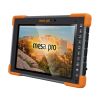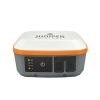Juniper Mesa 4 Rugged Tablet Computers
Features
- Waterproof, dustproof, shockproof
- Intel Gen12 UHD graphics and Windows 11 Pro OS
- Upgraded 4G cellular module (2x faster than Mesa 3)
- Free ground shipping
- Expedited repair and warranty service
- Lifetime technical support
- More
The Mesa 4 Rugged Tablet running Windows 11 offers powerful new functionality while retaining impressive features from the popular Mesa 3 Rugged Tablet. Its latest generation Intel processor is ready to run even the most demanding field data collection application, and its rugged ergonomic design is ready to handle a long day on the job in some of the harshest environments out there.
Built Juniper Rugged
Meeting IP68 and MIL-STD-810H ratings, the Mesa 4 is waterproof, dustproof, and shockproof. Rest assured rain, extreme temperatures, and dirt won’t stop a productive workday.
Powerful Processing Power
Expect lightning-fast speeds all day long with the Mesa 4’s latest generation N200 processor and 8 or 16 GBs of system memory (RAM). Running a full Windows 11 OS, this device is made to handle large files and detailed maps.
All-Day Usability
From its ergonomic enclosure to its sunlight-readable display to its all-day battery life, the Mesa 4 is made for long days on the job.
Carefully Designed and Supported
It’s more than a rugged tablet. Designed and assembled in the United States, the Mesa 4 promises device longevity and data protection. If it becomes necessary, each device is proudly supported by live and personalized customer support.
- Mesa 4 rugged tablet computer
- Standard removable battery
- AC wall charger with international plug kit
- Capacitive small-tip stylus w/tether
- Quick Start Guide
- Hand strap
- Connector port dust cover
In The News
Wildfire Prevention in the Sierra Nevada Region with the Yuba Watershed Institute
Though recent wildfires have sparked new conversations about wildfire management and response, groups like the Yuba Watershed Institute have been monitoring the forests and water resources of the Sierra Nevada region for decades, managing approximately 5,000 acres of land with the Bureau of Land Management (BLM) and about 7,000 acres in private land partnerships. The goal of the Institute is to work with local communities and land agencies to improve watershed and forestry management through informed practices and public outreach. The goals of the Yuba Watershed Institute are three-fold: Improve the ability of fire suppression agencies like the California Department of Forestry and Fire Protection ( CAL FIRE ) and the US Forest Service.
Read MoreWave Sensors Integration with NexSens Buoys: A Cutting-Edge Solution for Wave Measurment
Real-time wave data supports accurate weather prediction, safe and efficient maritime operations, and provides valuable safety and operating condition information for recreation and commercial fishing. Understanding wave dynamics also helps with the design of protective coastal structures like seawalls, breakwaters, and jetties. It also supports better prediction of their impact on sediment transport and coastal geomorphology. Wave data is a key factor in qualifying and designing offshore wind farms and harnessing kinetic energy for electrical generation. It helps with the understanding of ocean-atmosphere interactions and contributes to studies of sea-level rise and climate change impacts.
Read MoreSpring 2025 Environmental Monitor Available Now
In the Spring 2025 edition of the Environmental Monitor, we highlight partnerships across the world and the importance of collaboration between government agencies, universities, environmental groups, local communities, and other stakeholders. From great white shark research in Cape Cod to monitoring fisheries in Lake Erie, this latest edition underscores partnerships that connect stakeholders in a watershed through environmental data. With an emphasis on data sharing, a combination of real-time and discrete sampling keeps the public and partners informed of environmental conditions. Our writers also sought out science professionals dedicated to working with peers within and outside of the environmental sector.
Read More














































